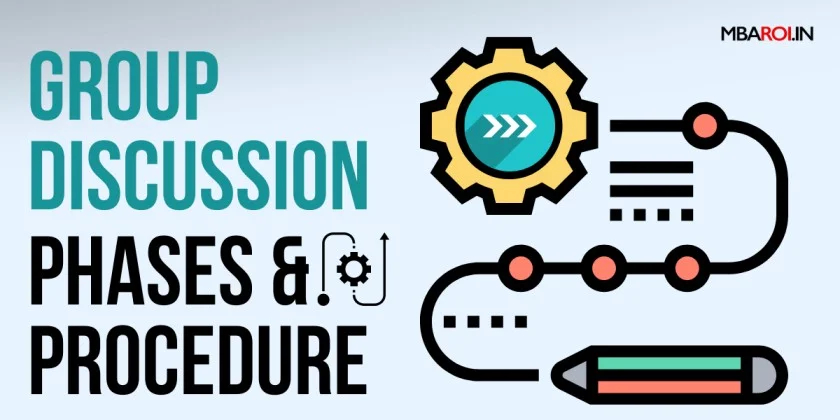Phases of Group Discussion - Procedure of GD

There is a prevalent use and practical value in using group discussion as an instrument for selecting and analyzing MBA candidates. Although there is wide use of GD as a selection tool but the process is not always very clearly understood. When the MBA selection process is laid down in GD form, it is viewed as a catalyst response activity, as a form of goal-seeking behaviour, and measuring how the participants mediate the life spaces. This article resolves to understand the Procedure and the Phases in GD Process in MBA selections.
GD Phases and Procedures
GD involves:
- Panelists: Panelists are a group of 4 to 5 people who judge the Group Discussion based on evaluation parameters. Parameters may be different in different MBA Colleges but the general procedure remains the same.
- Participants: Participants may range from 7 to 12 members put together in a group, which is decided based upon the available strength of candidates for the test.
- Duration: Average allotted duration for Group Discussion is 15 to 20 minutes. It may vary with the number of candidates present for the test. Panelists can also decide to extend or end the discussion time. E.g. in IIFT selection, a GD can prolong up to 45 minutes.
Steps in GD Procedure
- Topics Declaration: Any technical, factual, case study, or abstract topic is announced for discussion.
- Preparation Time allowance: 3 minutes of preparation time is allowed to participants, which can also be extended in certain cases.
- Lead Initiates the Discussion: which is trailed by others- Any participant can take the lead to start the discussion. Other participants can keep adding their viewpoints. Every participant gets their chance to communicate their views on the topic one after the other.
- Summarising the Discussion: GD ends when the panelists ask to stop the discussion. They may ask one participant to summarize the GD. When summarising, cover all the discussed points that were part of the discussion and conclude the discussion effectively. Mostly a lesser participating member is asked to summarize, but others can speak.
- Evaluation of each Participant’s Presentation: Based on the parameters, final scores are calculated and scores are announced.
| Admission in MBA/PGDM Open For Below Colleges | |
| TAPMI | Great Lakes Institute |
| Taxila Business School | RIIM, Pune |
| Genesis Business School | GIM (Goa) |
| MDI, Gurgaon |
Phases in Group Discussion
Group Discussions can be precisely divided into 3 phases. For a successful GD, initiation, summarization, and good content is very important. During the GD, the B-School Panelists look forward to these three stages for a proper progression of the discussion.
- Initiation: The one who grabs the initiating opportunity attains two birds with one stone. He gets the chance to speak first and at the same time grabs the attention of Panelists and fellow participants. This builds a favourable first impression if good content is presented with confidence. Try not to stammer or present wrong facts at this time.
- A good introduction to the topic gives the discussion the right perspective for further talks. If you have a good insight into the topic, initiate the GD.
- At this stage, if you have fear of speaking up, please remember that communication is more important than the feeling of fear. Try to think positively and get ideas using the POPBEANS technique.
- Body Of Content: It is sometimes difficult to explain your points in an intelligible manner, so create a Silence Zone while you speak. To overcome the distracting situations:
- Use the PREC technique (Point, Rationale, Example, and Conclusion). This helps you to present your thoughts coherently.
- Use confident body language. Maintain a confident, upright posture, eye contact, and a polite tone.
- Start a GD in a way that you makes a remarkable first impression. Use quotes, definitions, questions, shocking statements, statistics, short stories, and general statements.
- During this stage, a power struggle is inevitable. Members may contest based on facts and figures. Agreements and oppositions go hand in hand. Some members emerge dominant and differences of opinions are bound to arise. So, stay calm but active and show your problem-solving skills. After the power struggle, group members get calmer. At this stage give the GD a correct direction towards resolution. Next is the performance stage where competencies, attitude, and aptitude are observed and evaluated. Decisions naturally become apparent from group collaborations happening at this stage and the members start to move towards unanimity if there is a possibility.
- Conclusion: Not every GD needs to conclude. Even when the GD is not concluded, the members of the group get evaluated always. The conclusion arrives when the entire group arrives at one proclamation i.e. in favour or against a topic. If in case the conclusion has not been reached, summarise the discussion in a nutshell based on what was discussed in GD. When summarising, remember:
- Not to take up a new point.
- Do not share only your perspective.
- Summarise all the viewpoints of the topic.
- Keep it brief and crisp.
- Include all important points discussed.
- Do not speak more without listening to what others have to say
- Use statements like – “We have just had a great group discussion and, as a group, we have weighed different aspects of this topic. Some of us were in favour and some were of the other viewpoint ……..”
The above methods help to bring out your A-game and make an impact to deliver a successful GD.